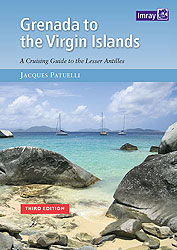
Destinations
Map of Lesser Antilles
Everything about
archipelago
Sailing in the Lesser
Antilles(charts with
routes and wp)
Services directory
(Blue pages)
Order the guide
Mail
Last informations
Warning
St Barthelemy

|
During his second voyage Columbus did the only Spanish favour to this dry and hilly island. He gave it the name of his brother Bartolomeo, in French Barthelemy, but it is popularly known as St Barts or St-Barth. Around 1685 a hundred or so peasants from western France took over St Barts, which until then everyone had ignored. By a century later their numbers had swollen to 600, who worked themselves into the ground to cultivate such a barren spot. And despite the best efforts of the British who developed a sudden interest in the island's strategic value, they clung on to what they had. Then in 1784 the ungrateful king Louis XVI ceded the island and its 600 inhabitants to Sweden in return for a vague right to have a French trading base in Gothenburg. |
The result was that Caribbean trade
could tranship through a port sheltered
from the fighting elsewhere.
But the wars
ended and a century later the Swedish
governor thought his small island with its
600 poor peasants scratching a living on
its slopes was all too much. |
|
|||||




